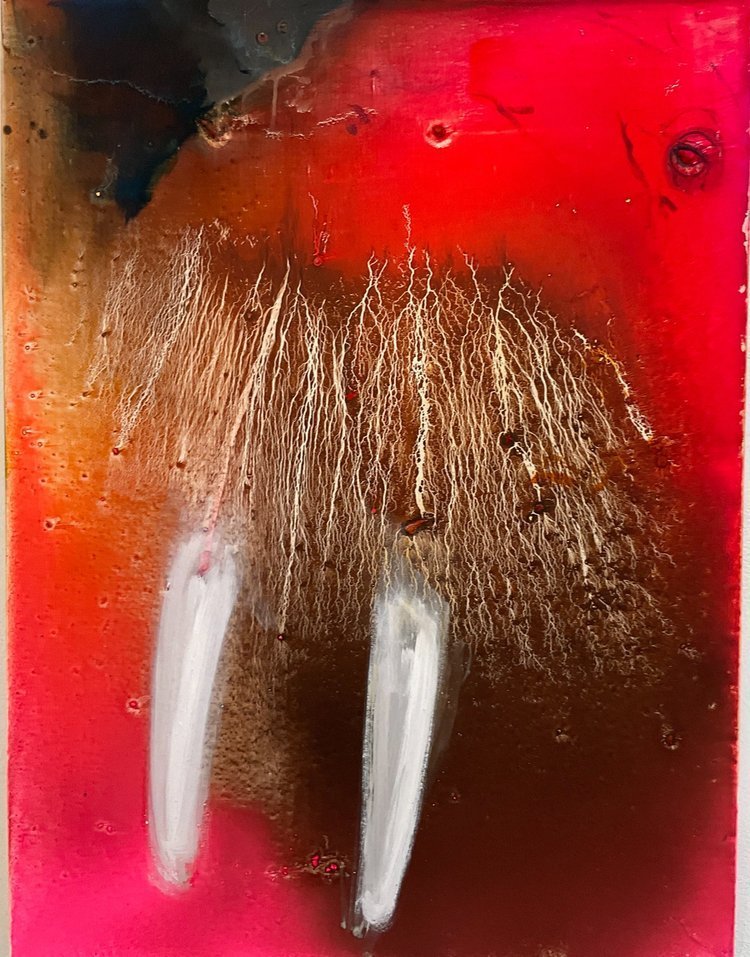The Brooklyn Rail
Barbara Friedman
All Rude and Lumpy Matter
FROSCH&CO
February 27–April 6, 2025
New York
New York-based artist Barbara Friedman, who is stylistically rooted in Bay Area figurative and California funk art traditions, presents rebellion against the seriousness of Abstract Expressionism and Color Field painting in All Rude and Lumpy Matter, a frisky mediation of chance surprises. Friedman began as a printmaker, a fact evidenced by All Rude and Lumpy Matter’s limitation of paint handling that engenders sophisticated, barely manipulated surfaces.
The exhibit marks the culmination of Friedman’s work during COVID: “It felt right to make characters that were kissing, licking, and nuzzling each other when everyone was so separate.” Nudging images forward with as little intervention as possible, the works on view reserve narrative until after the painting is done. She starts by placing a smoothly stretched, oil-primed canvas on the floor and pours from cans of paint variously thinned with turpentine, unleashing rivulets and dried bits and lumpy bilge that unpredictably puddle and interact physically and chemically. Paint, gravity, and porosity reach a compromise, like sedimentation at the ocean’s shoreline. Silky, alligatored washes of dappled color bleed into each other like water filtering through sand, punctuated by grit, clumps, and other incongruous leavings of fluid dynamics.
For some time, Friedman has let images materialize from empty yet lively chromatic zones. In 2020, she recognized a Pinocchio face in the underpainting of Enjambment (a painting not in this exhibit) and captured the image with negative space, in essence carving away excess background so that Pinocchio could emerge. All Rude and Lumpy Matter extends that process of search and minimal intervention. Mash Up (2021) defines and vivifies palpable, yellow emptiness by framing it with a bunny clasping a human face. Swiftly interpreting a mammal’s head in All Ears (2024) triggers seeing the wash below as legs and paws, sustaining various degrees of an animal’s presence and disappearance in mostly flat but hallucinogenic colors. With Buttons (2024) Friedman strove to tease out a face at the top of the painting but honored its guide by emphasizing outlines of a bird’s head, a fish, and a lace-collared, button-up shirt within a blue and red void of floating detritus. Perhaps the most complex piece in the exhibition is Strutting Chicken (2024), a recycled surface that joins gestural marks buried under a first pour and a swiftly sketched eye to make a bull. A second bright yellow, green, and red pour needed only one gold foot to make it poultry. Spare reference to the two animals activates the colorful upper and lower left-hand corners of the piece; the two abstract zones alternately make the bull’s ears and neck, a delirious slide into dissipation, and a Dionysian garland.
Made in one lucky pour without any further intervention by the artist, Golliwog (2024) melds acid green psychedelic light display with Superfund toxicity, suggesting amoebae and other animalcules subdividing on a microscope slide layers below a tiny, drifting, cross-sectioned heart. Golliwog enjoys only whiffs of boundaries as a dual micro- and macrocosmic form and is the most artist-unoccupied piece of the show.
Friedman describes the evolution of her paintings in terms of not repeating herself and building tension. Underpainting, recycling paintings, and having no predetermined image have always been important to her. Previous series, such as “Uninvited Guest,” “Unreliable Narrators,” and “Darkness at The Edge of Town” suggested landscapes by inserting small figures and buildings into underpainting, a move she’s abandoned in this show. By turns ambiguous and concrete, Friedman’s paintings for All Rude and Lumpy Matter structure figurative abstraction with incidental eyes and nipples from which a viewer can extrapolate bodies—faces, noses, feet, and paws. Friedman surfs atop ambiguity and her own unanswered questions; for instance, wondering if the classical finish of rendering such points of conspicuity is perhaps "too precise," without sinking into self-criticism. Signals of new work are already forming offstage: inventory and analysis of All Rude and Lumpy Matter is spawning trademark, inherent permissiveness. She says about her paintings, “I am learning them, and they are teaching me. I am addicted to not knowing what they are going to be.”
From a beautiful, found chaos of minimal doing, Friedman steps back even further, clinching the sense of totality she’s after: an organically rich, effortless-looking surface that prioritizes real life. Friedman puts underpainting to work, employs negative space imaginatively, elevates fugitive treasure, and most importantly, knows when to stop. All Rude and Lumpy Matter doesn’t showcase best hits; rather, it reflects humanity in humble, silly, vulnerable animal and life forms. And when it comes to bodies, chance can equal fate.





























